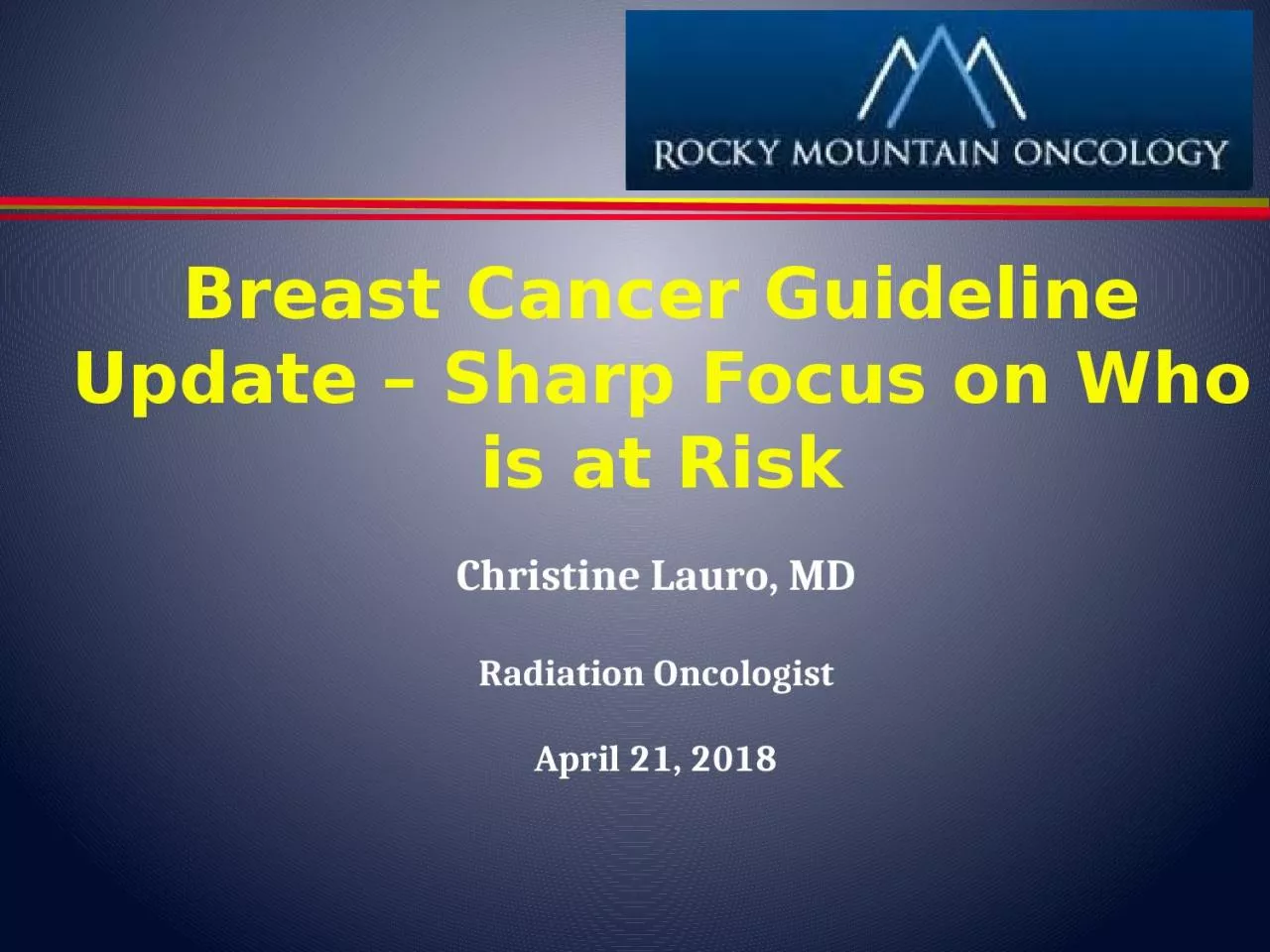

Christine Lauro MD Radiation Oncologist April 21 2018 Outline Epidemiology Breast Cancer Risk FactorsSymptoms Benefits of Screening Review of Guidelines Epidemiology Epidemiology The chance of developing an invasive breast cancer at some time in a womans life is about 1 in 8 12 ID: 919534
Download Presentation The PPT/PDF document "Breast Cancer Guideline Update – Sharp..." is the property of its rightful owner. Permission is granted to download and print the materials on this web site for personal, non-commercial use only, and to display it on your personal computer provided you do not modify the materials and that you retain all copyright notices contained in the materials. By downloading content from our website, you accept the terms of this agreement.
Slide1
Breast Cancer Guideline Update – Sharp Focus on Who is at Risk
Christine Lauro, MDRadiation OncologistApril 21, 2018
Slide2Outline
EpidemiologyBreast Cancer Risk Factors/SymptomsBenefits of ScreeningReview of Guidelines
Slide3Epidemiology
Slide4Slide5Epidemiology
The chance of developing an invasive breast cancer at some time in a woman’s life is about 1 in 8 (12%).In 2013, 232,340 new cases of invasive breast cancer will be diagnosed in women.64,600 new cases of carcinoma in situ will be diagnosed.39,620 women will die from breast cancer.
Slide6Slide7Slide8What may increase a patient’s breast cancer risk?
Breast cancer-related genes (BRCA 1 or BRCA2)Menarche prior to age 12NulliparousStarting menopause after 55Hormone replacement therapy for more than 5 yearsBirth control pillsFamily history of breast cancerObesity
Slide9What are physical exam findings of breast cancer?
Mass in breast or axillaIrritation or dimpling of breast skin (orange peel appearance or “Peau d’Orange”)Redness or flaky skin of the nipple areolar complex (Paget’s disease)Nipple inversionNipple discharge other than breast milk, including blood
Slide10Peau d’Orange
Slide11Paget’s Disease of the Breast
Slide12Breast Cancer Screening
A mammogram is an X-ray of the breastBest method to find breast cancer early
Slide13Mammogram
Annual screening MLO, CCDiagnostic if something on screening USCompression for density; magnification for calcifications
Slide14What is Tomosynthesis?
Slide15Digital Breast Tomosynthesis
Increases detection rates of small invasive cancersDecreases false positive callback ratesImproves margin analysis & lesion conspicuity by decreasing effect of overlying breast tissueImproves localization of “one view only” lesionsHelps distinguish skin lesions from breast lesions
Slide16Courtesy of Dr. Shannon MacDonald, ASTRO Spring Refresher 2018
Slide17Slide18Specimen radiograph after lumpectomy to confirm clip and radiographic lesion or calcifications
Rare to obtain post-lumpectomy mammogram
Slide19Skaane
, Per, et al. "Comparison of digital mammography alone and digital mammography plus tomosynthesis in a population-based screening program." Radiology
267.1 (2013): 47-56.
Slide20MRI Breast
Used for selected patients & no clear consensus on how to select patientsDifficult to detect lesions on mammo or tomo (extremely dense breast tissue, ILC, assess feasibility of breast conservation)Performed prone, difficult for claustrophobic patients, FALSE POSITIVE (anxiety, delay to definitive treatment, increased mastectomy rate, cost)
Slide21Who should undergo screening?
Prior to 2015….Screening with mammography and clinical breast exam annually starting age 40.
Slide22Guidelines Since 2015…
U.S. Preventative Services Task ForceAges 40-49: Decision to start screening prior to age 50 should be individual; women who place a higher value on the potential benefit than the potential harms may choose to begin biennial screening between the ages of 40 and 49.Age 50-74: Biennial screening is recommended.
Slide23Guidelines Since 2015…
American Cancer SocietyAges 40-44: Decision to start annual screening should be individual.Ages 45-54: Annual mammographyAge 55+: Biennial screening, or choose annual mammogram
Slide24Summary of Guidelines
Slide25Breast Cancer Screening
ProsDetect breast cancer earlierBetter cure ratesLess treatment for cure
Slide26Breast Cancer Statistics Since Start of Mammography
Slide27Collaboration of 6 simulation models using national data on incidence, digital mammography performance, treatment effects and other-cause mortality.
Conclusion: Bienniel strategies were most efficient for average-risk women.Limitations: non-adherence not considered; other imaging technologies not considered; family history not considered.Mandelblatt, Jeanne S., et al. "Collaborative Modeling of the Benefits and Harms Associated With Different US Breast Cancer Screening Strategies, Benefits
and Harms of US Breast Cancer Screening Strategies."
Annals of internal medicine
164.4 (2016): 215-225
.
Slide28Berry, Donald A., et al. "Effect of screening and adjuvant therapy on mortality from breast cancer." New England Journal of Medicine 353.17 (2005): 1784-1792.
Slide29Cost of Screening vs. Chemotherapy in WY
Screening mammogram: $59.63Herceptin x 12 doses: $18,898.56= 316 mammogramsPerjeta x 12 doses: $53,877.60= 903 mammogramsMedicare pricing, 2017
Slide30Clinical Pictures
Slide31Clinical Pictures
Slide32Summary
Breast cancer is the most common cancer in American womenMammograms have been shown to increase detection of breast cancers at an earlier, more curable stage.Optimal frequency and start of mammograms are controversial.
Slide33Thanks!